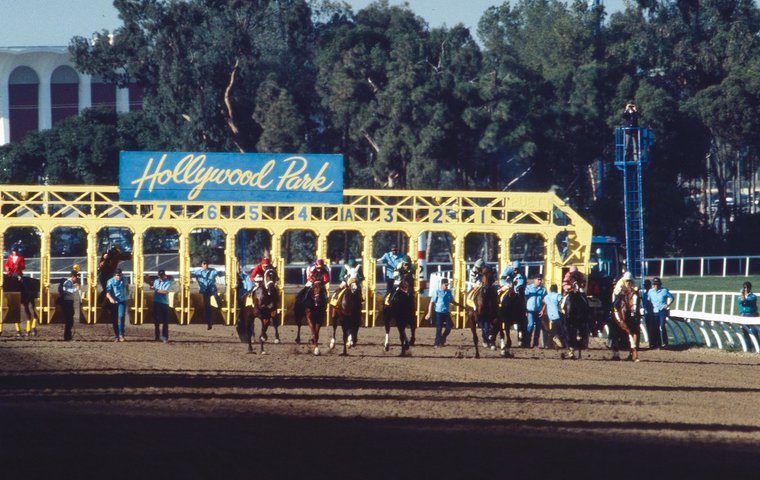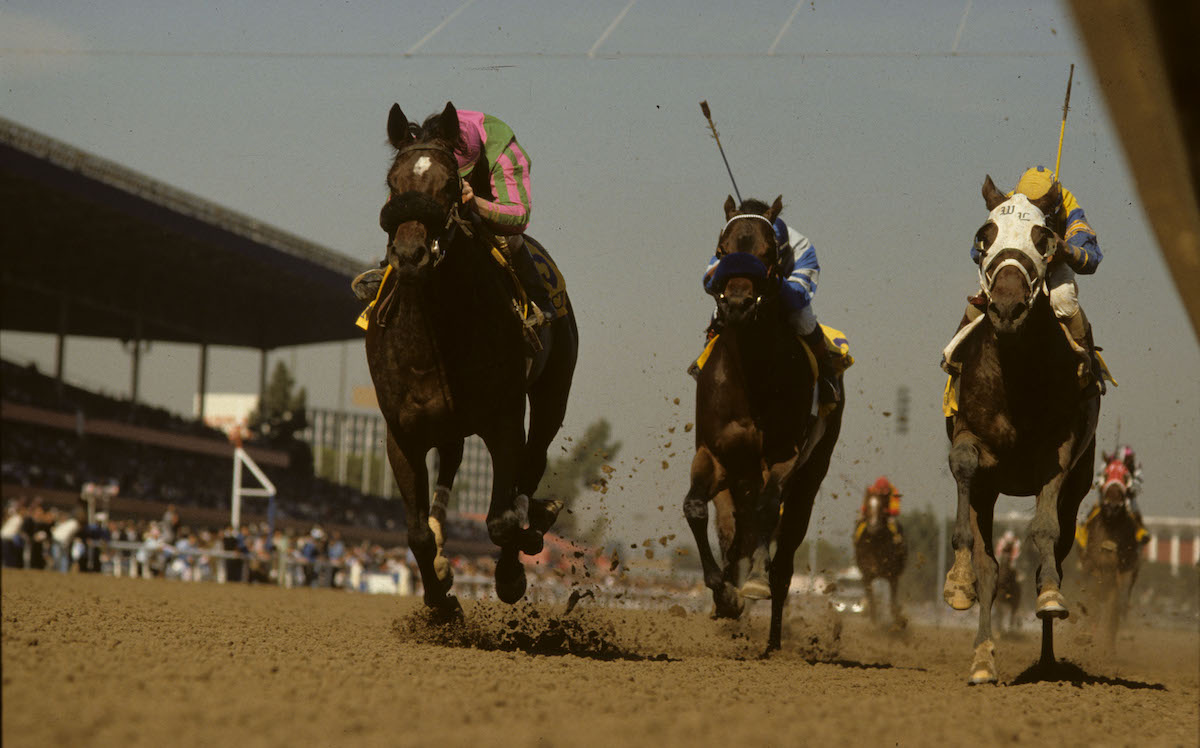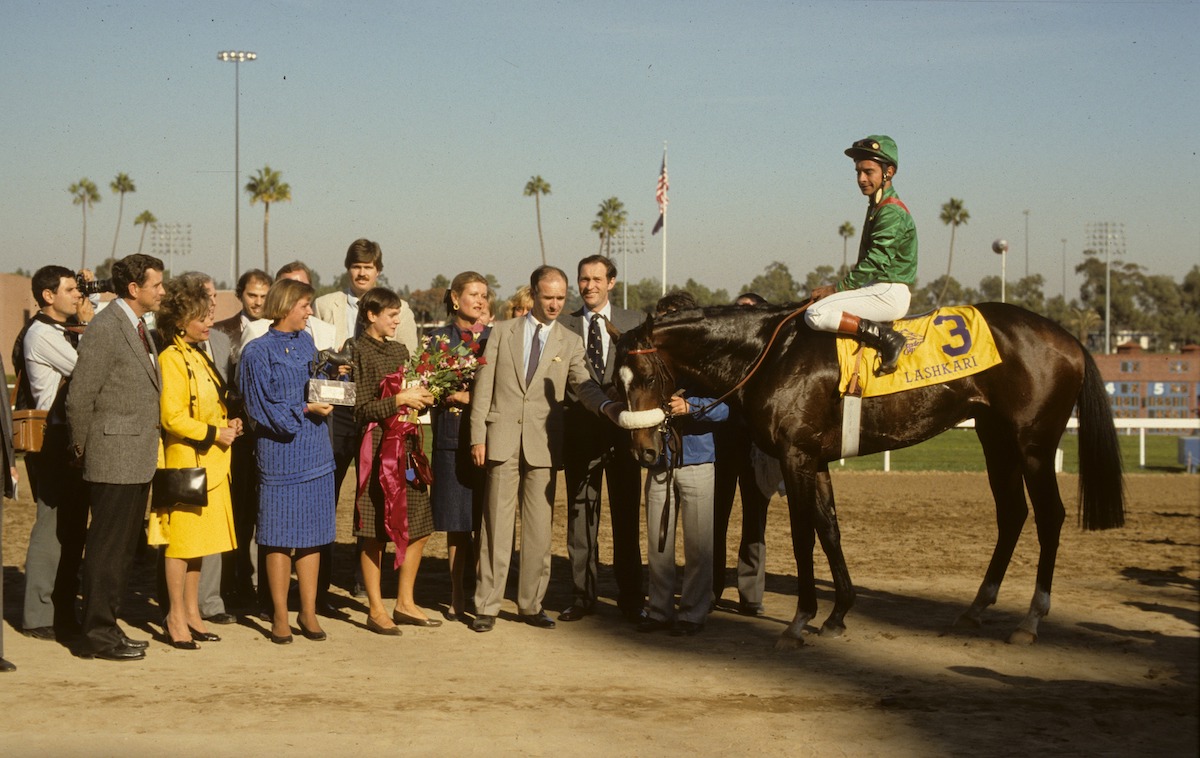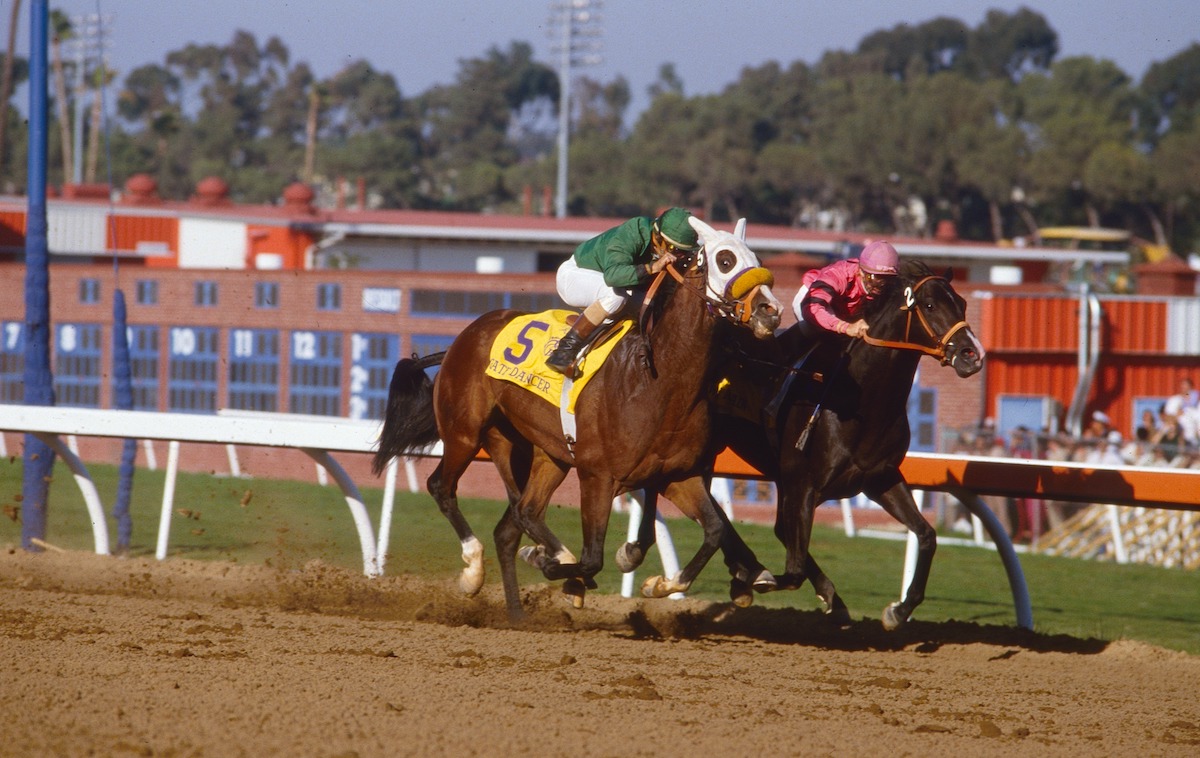
As America’s two-day spectacular prepares for its 40th anniversary at Santa Anita, Steve Dennis recalls how the inaugural event fully lived up to advance billing at Hollywood Park in 1984
Nostalgia is a sweet fix, the rose-tinted repetition of the way we were, a daydreamy diversion from the way we are, and to revisit the memory of the inaugural Breeders’ Cup is to wade waist-deep in it.
Those sun-yellow starting gates at Hollywood Park, the golden cast to the light in the southern California fall, the stark beauty of seven select contests, that pre-internet thrill of unfamiliar American horses and jockeys being new and wildly exciting to the Europeans and vice versa, and the effervescent feeling of going boldly together into a bright new future – all enough to quicken the pulse just as efficiently as they did on November 10, 1984, apparently half a lifetime ago but surely only yesterday.
 The Breeders’ Cup was a broad-brush gesture of intention, a bid to sculpt the modern face of a time-honoured sport. Ten million dollars in play on one afternoon – a truly jaw-dropping concept – went a long way towards securing instant acceptance, but there’s more to life than money.
The Breeders’ Cup was a broad-brush gesture of intention, a bid to sculpt the modern face of a time-honoured sport. Ten million dollars in play on one afternoon – a truly jaw-dropping concept – went a long way towards securing instant acceptance, but there’s more to life than money.
What racing’s new baby needed straight away was something money couldn’t buy – credibility, a global appeal, excitement, controversy, an even share of the spoils among the competitors, champions taking their rightful place and the odd longshot to underline the gripping uncertainty of racing. It had to be a half-hourly assault on the senses that left every observer reeling with excitement.
Tick, tick, tick … every box. The first Breeders’ Cup had something for everyone, even Hollywood A-listers Frank Sinatra, Larry Hagman and John Forsythe, the latter a noted owner-breeder, all picked out by NBC’s roving cameraman among a crowd of 64,000 as they played the undemanding role of railbird for an afternoon.
Giant leap for horse racing
The first small step for a horse, the giant leap for horse racing, arrived with the Juvenile, when the 7-10 favourite Chief’s Crown came into the race with a string of G1 victories to his name and promptly added another one for trainer Roger Laurin – son of Lucien, trainer of Secretariat – and jockey Don MacBeth.
He produced a thrilling late surge to run down Spend A Buck and turn back Tank’s Prospect, winning by three-quarters of a length, and the impact of his victory was made plain when, as he crossed the line, racecaller Tom Durkin noted that “a champion is crowned!”.
The notion that the Breeders’ Cup would be the birthplace of champions thus took early root, and not only did Chief’s Crown win the Eclipse Award in the two-year-old colt division, but Spend A Buck went on to win the Kentucky Derby and Tank’s Prospect took the Preakness.
Credibility, then, which was followed half an hour later by drama and controversy, as 74-1 outsider Fran’s Valentine fought her way to victory in the Juvenile Fillies but landed a low blow in the process.
She saw off the late rush of 22-1 shot Outstandingly – ridden by Walter Guerra and trained locally by Frank ‘Pancho’ Martin, racing in the hot pink silks previously carried by Triple Crown hero Affirmed – to get the money by a half-length.
However, after a lingering, excruciating ten-minute inquiry the stewards took her number down for interference at the top of the stretch and demoted her to tenth, a move that reportedly reduced jockey Pat Valenzuela to tears.
“I had a lot of horse – I just didn’t have anywhere to go,” said Valenzuela. “I probably would ride her the same way if it happened again.”
First glamour, then drama. The Breeders’ Cup was living up to every expectation, and then the fragile 6-5 favourite Eillo sizzled his way to victory in the Sprint, going gate-to-wire under Craig Perret.
The four-year-old had daylight on his side at the sixteenth-pole but Commemorate was coming at him hard all the way to the wire, and by the time the camera clicked Eillo was only a nose in front, that nose adorned by the snappiest of yellow bridles. It was by some way the biggest victory in the long career of trainer Budd Lepman.
Next up was the Mile on turf, and a chance for Europe to join the party, something that would be vital if the event was to gain traction outside the US. The shippers were led by G1 Prix Jacques le Marois winner Lear Fan and backed up by G3 winner Prego, owned by legendary bloodstock tycoon Robert Sangster, but the unusual demands presented by US racing proved their downfall.
Lear Fan was very reluctant to enter the gate, possibly for aesthetic reasons as he’d never seen yellow starting stalls before, and Prego completely flunked the start, losing a dozen lengths on the leader before they had gone a furlong.
It wasn’t all bad news for Sangster, though, as Prego was coupled at 7-5 favourite with his top-class former British runner Royal Heroine, now trained in California by expat Brit John Gosden and the lone filly in the field, and she produced the performance of her life.
She travelled sweetly behind the pace, quickened sharply under Fernando ‘the Bull’ Toro to lead a sixteenth out and drew off to beat Star Choice – ridden by the lavishly moustachioed Jim McKnight – by a length and a half in 1m 32.6s, a new North American record for a mile on turf.
“I didn’t want to move too soon, but as soon as she got in the clear, she accelerated, she was gone,” said Toro.
Connection across the pond
The British raiders were routed, but the victory in Sangster’s colours made a connection across the pond, helping to embed the new event in the European consciousness. That process reached critical mass in the $2m Turf, won by the Alain de Royer-Dupre-trained Lashkari, who carried the Aga Khan’s globally renowned green and red silks to a 53-1 longshot success for France that was greeted with jubilation by the Breeders’ Cup committee, if not by bettors.
There were better-fancied Europeans in opposition including the magnificent French mare All Along, as well as the fearsome Australian globetrotter Strawberry Road, but Lashkari upset the field with a Gallic panache under perennial French champion jockey Yves Saint-Martin.
 He came nonchalantly late to deny the mighty All Along by a neck, an exacta lifted straight from the Bois de Boulogne.
He came nonchalantly late to deny the mighty All Along by a neck, an exacta lifted straight from the Bois de Boulogne.
It was exactly what the ‘world championships’ needed, an overseas winner to encourage further international competition that had begun to gather pace in any case, with the pioneering Arlington Million victory of Tolomeo – trained in England by Italian maestro Luca Cumani and ridden by Irish all-time great Pat Eddery – shrinking the Atlantic and broadening the mind for Europe’s finest.
In between those two turf contests, the redoubtable grey filly Princess Rooney had signed for the most straightforward, least dramatic success of the afternoon when clearing right away to win the Distaff by seven lengths, justifying 7-10 odds for trainer Neil Drysdale and Eddie Delahoussaye.
“I felt good about her, but I never thought she could win like that,” said Drysdale. It was a romp, a parade, a reminder that class was the cornerstone of the new racing concept; Princess Rooney had a ton of it. The victory would assure her of an Eclipse Award alongside Chief’s Crown, Eillo, Royal Heroine and Outstandingly, the power of the Cup already leaving an impression on voters’ minds.
And yet the best was still to come, the $3m Classic, the perfect end to a perfect day, one of the most dramatic, exhilarating races in the entire Breeders’ Cup canon.
The hot favourite and Eclipse Award winner Slew o’ Gold brought a four-race winning streak in G1s to the table, Gate Dancer had won the Preakness, triple G1 winner Desert Wine and the speedy Precisionist were strongly fancied. The supplemented Wild Again, whose trainer Vincent Timphony had advised his connections to fork over $360,000 to put their 31-1 shot in the field, was not.
Nose-to-nose
What happened next brought the racing world to its feet. They went out fast, 22⅗s for the first quarter, Pat Day pushing Wild Again into the lead over Precisionist. On the far turn Angel Cordero drove the mighty Slew o’ Gold up to challenge Wild Again and at the top of the lane they went nose-to-nose.
 Day was coaxing Wild Again with a hand-ride, Cordero was ordering Slew o’ Gold forward under an insistent drive, and then along came Gate Dancer, looking like a childhood nightmare in his vast, ghostly white hood, bearing down remorselessly upon the leaders with an eighth of a mile to run.
Day was coaxing Wild Again with a hand-ride, Cordero was ordering Slew o’ Gold forward under an insistent drive, and then along came Gate Dancer, looking like a childhood nightmare in his vast, ghostly white hood, bearing down remorselessly upon the leaders with an eighth of a mile to run.
It got rough. Wild Again bumped Slew o’ Gold, Slew o’ Gold bumped Wild Again. Gate Dancer muscled in from the outside and pushed Slew o’ Gold into Wild Again, who held his short lead as a drowning man holds a lifebelt.
Three horses lunged for the wire, the longshot and the chalk and the ghost vying for the richest purse in the sport, and when the smoke cleared the admirably, unbearably tenacious Wild Again had it by a head from Gate Dancer, with Slew o’ Gold a half-length back in third.
“I tapped him once at the top of the stretch,” said Day. “I knew he was giving me his very best, and Slew o’ Gold didn’t want to run by him. Wild Again ran the race of his life.”
The stewards looked long and lovingly at the film of the finish, it being the sort of race you could watch over and over again without getting bored, and decided that Gate Dancer was in the wrong, and put him down to third. Wild Again may have been lucky to escape official censure; Slew o’ Gold was certainly unlucky.
“What a way to conclude racing’s greatest day ever,” yelped one of the NBC summarisers, and we’ll forgive him that slightly hysterical rebuke to more than 250 years of Thoroughbred history, because it was indeed a great day and indeed a great race, and the Breeders’ Cup was up and running at a headlong gallop.
In the seven races on that breathless afternoon there were four winning favourites, three longshots, seven winning jockeys, seven winning trainers, a European winner, two disqualifications, five champions and one of the most exciting finishes ever seen. Tick, tick, tick. If life is a numbers game, the Breeders’ Cup had won the lottery with its first ticket.
Thirty-nine years later and the memories are as bright as that blue California sky, as vivid as that golden starting gate. Hollywood Park is long gone but its legacy remains, ready to be resurrected at the slightest provocation.
All it takes is that recent video of an emotional Fernando Toro, or a fleeting glimpse of the Aga Khan’s gleaming green silks, or some fine grey filly drawing easily away from her rivals, and we’re back there once again, leaning over the white rail at Hollypark, watching with delight as the first draft of modern racing history is written before our eyes.
So many things aren’t what they used to be, but nostalgia – and the Breeders’ Cup – never disappoints.
• Visit the Breeders’ Cup website and the Breeders’ Cup Challenge web page
‘The Breeders’ Cup puts equine safety first and foremost’ – Q+A with Drew Fleming
View the latest TRC Global Rankings for horses / jockeys / trainers


